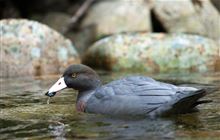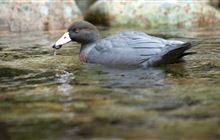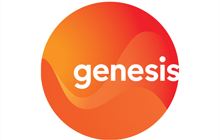Record number of whio ducklings on Mt Taranaki
Archived content: This media release was accurate on the date of publication.
Introduction
A record number of whio ducklings have been located on Mt Taranaki in what is proving to be a boom year for the rare native blue duck.Date: 08 January 2018
56 ducklings have been found by DOC rangers on the eight rivers that DOC surveys on the Mounga as part of the Whio Forever partnership with Genesis.
DOC biodiversity ranger Joe Carson says on Monday 8 January three more young male ducks were released into the Waipuku Stream on the eastern side of Mt Taranaki, further boosting the whio population.
"These three juvenile ducks will increase the genetic pool of our population, helping to diversify and strengthen the lines. The release caps off a record year for breeding with 56 ducklings counted within the surveyed rivers, signaling positive movement towards a self-sustaining population of whio on Mt Taranaki," she says.
The three new ducks were bred at the Nga Manu Nature Reserve in Waikanae. They are 3.5 months old and have spent the last few weeks at DOC's Turangi whio creche to 'harden up' before being released into the wild.
The local whio/blue duck population on Mt Taranaki was designated "functionally extinct" in 1945 because of predation by stoats and rats. A predator predator programme covering 7,500 ha of the park was started in 2003. With a lot of hard work by DOC, the Central North Island Blue Duck Trust and the Genesis Energy National Whio Forever programme, the whio population has now built up to 33 pairs.
Genesis' Group Manager, Corporate Relations, Emma-Kate Greer, says it is heartwarming to see the programme returning such excellent results.
"When the partnership began in 2011 Genesis hoped to work with DOC and other community groups to secure the future of the whio - these promising results are another step towards that goal," says Greer.
This work is being complemented by environmental project Taranaki Mounga which has extended the safe area for whio and kiwi on Mt Taranaki by increasing the stoat trapping network to 11,000 ha in the last year.
"Taranaki Mounga is delighted to build on the great work already underway to increase the whio population on the mountain. Whio are particularly vulnerable during nesting time so it's fantastic to hear we have a record number of chicks on Mt Taranaki this breeding season," says Taranaki Mounga Project Manager Sean Zieltjes.
The three new whio were released into the Waipuku Stream on the eastern side of the Mounga.
Background information on whio
- The whio is a threatened species of native duck that is only found in New Zealand's fast flowing waters. Featured on New Zealand's $10 note and with an estimated nationwide population of less than 3000 birds, whio are rarer than kiwi.
- Whio are adapted to live on fast-flowing rivers so finding whio means you will also find clean, fast-flowing water with a good supply of underwater insects.
- This makes whio important indicators of ecosystem health – they only exist where there are high quality clean and healthy waterways.
Whio Forever
- Genesis Energy has a strong historic association with whio through the Tongariro Power Scheme and in 2010 this association grew through the establishment of Whio Awareness Month (March).
- Today, Genesis Energy and DOC continue their partnership through the Whio Forever Programme, which aims to secure the future of whio in the wild and ensure New Zealanders understand and value whio in our rivers.
- The support of Genesis Energy and the work of DOC has enabled the Whio Recovery Plan to be implemented.
- Whio Forever has enabled DOC to double the number of managed pairs to more than 560 along 14,000 km of North and South Island rivers that are protected by more than 5000 new stoat traps.
Conservation issue
- Whio are eaten by stoats, ferrets and cats, with the largest impact during nesting time when eggs, young and females are vulnerable, and also when females are in moult and can't fly.
- Extensive trapping can manage these predators, and work in key whio habitats by DOC and Genesis Energy on the Whio Forever Project has already seen an increase in whio numbers.
- Whio cannot be moved to predator-free islands like other species because of their reliance on large fast-flowing rivers.
- Pairs occupy approximately 1 km of water – so they need a lot of river to sustain a large population and they fiercely defend their territories, which makes it difficult to put them with other ducks in captivity.
- They are susceptible to flood events which destroy nests, fragment broods and wash away their valued food source.
Contact
Joe Carson, DOC Biodiversity Ranger
Phone : +64 27 577 3869
Sean Zieltjes, Taranaki Mounga Project Manager
Phone : +64 27 541 2462



